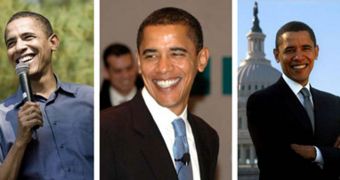In a new scientific study conducted on people's perceptions on politicians, it was revealed that people tended to alter the image they had of their candidate (or their opponent) in their mind, depending on preferences. The feelings that the politician incites in a person are a factor that directly influences the visual perception that person has on the official. In the new experiments, a number of people were shown photos of Barack Obama, and were asked to select which one they thought was most representative of the President. The results are puzzling, ScienceNow reports.
In the investigation, three photos of the Commander-in-Chief were shown to Democrats and Republicans. All the images showed Obama in various settings, but the hue of his skin had been digitally altered in some, and left as it was in others. When presented with the photographs, the Democrats proved to be more likely to select a picture of Obama with a lighter skin hue as the President's most representative one. On the other hand, Republicans proved more likely to be conservative, and selected the images in which the chief of state had the darkest skin color.
Details of the new research were published in the latest issue of the respected journal Proceedings of the National Academy of Sciences (PNAS). According to University of Chicago social psychologist Eugene Caruso, who has been a coauthor of the new paper, the results may be owed to the fact that more negative stereotypes about African Americans are connected to darker skin tones than to lighter ones. This means that skin tone has a significant influence on how we see someone. But the researchers were more interested in noticing if the causal relation worked the other way too.
In a new, experimental setup, a number of students (90 percent White and ten percent Black) were shown the pictures, and then asked to pinpoint which of them showed the President's “true essence.” The study also showed that the Liberals were twice more likely to select the picture showing Obama with a lighter skin tone than the Conservatives. Some 25 percent of the latter group chose the darker version of the photos, with only one percent of them selecting the brighter hues.
“This is the first study to show how the impact of political allegiances can extend down to our literal perception of the physical world and the people in it. The take-home message is that social stereotypes can be quite subtle, and they can work in ways that lie far below our awareness,” Cornell University social psychologist David Dunning says.

 14 DAY TRIAL //
14 DAY TRIAL //